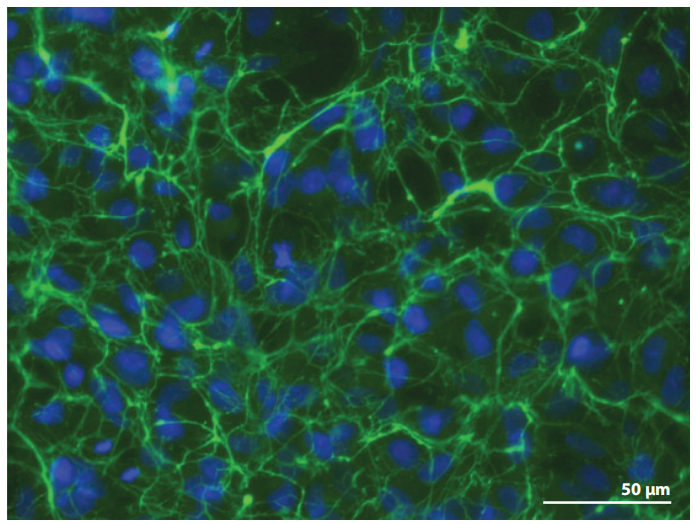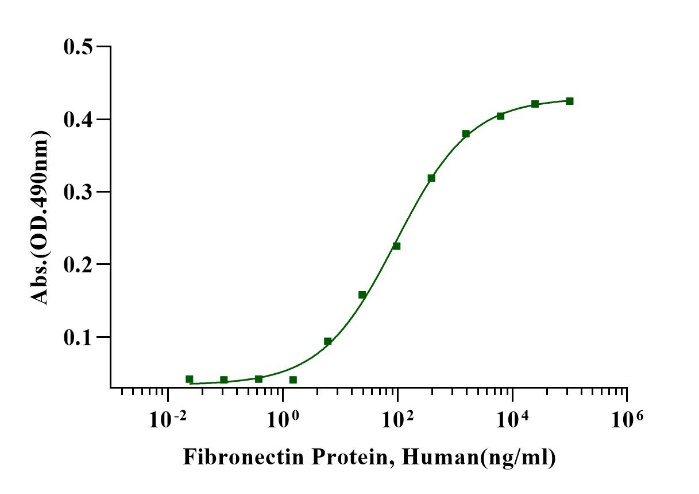Fibronectin: The Master of Cell Adhesion in Cell Culture

Introduction
Fibronectin is a high-molecular-weight glycoprotein found on the surface of various animal cells and within the extracellular matrix. It is composed of two subunits, each with a molecular weight of 220 kDa, linked by interchain disulfide bonds, resulting in an overall molecular mass of approximately 450 kDa. Fibronectin exhibits a distinctive V-shaped structure, which enables it to interact with multiple cell surface receptors, thereby regulating cell adhesion, migration, proliferation, and differentiation.
Functions of Fibronectin in Cell Culture
1.Promotion of Cell Adhesion and Spreading
During cell culture, cells need to attach to the culture dish or scaffold material to grow and divide normally. As a major component of the extracellular matrix (ECM), fibronectin promotes cell adhesion and spreading by binding to integrin receptors on the cell surface through its Arg-Gly-Asp-Ser (RGDS) sequence. This adhesion not only facilitates stable cell growth in the culture environment but also enhances cell proliferation efficiency.
In the early stages of cell culture, researchers often coat culture dishes or scaffold materials with fibronectin to promote rapid cell adhesion and spreading. This treatment significantly improves cell attachment efficiency and spreading area, facilitating subsequent experimental procedures. For example, when culturing BHK, CHO, and other cell lines, coating with 1-5 µg/cm² of fibronectin results in more pronounced cell adhesion and spreading.

Figure 1. Fibronectin (FN) fibrillar matrix surrounding cultured cells.HT1080 cells were cultured for 20 hours in medium containing 0.1 µM dexamethasone and 25 µg/ml mouse plasma FN, following the method of Brenner et al. (2000). The cells were then fixed and stained with an anti-FN monoclonal antibody (IC3), followed by fluorescence-labeled goat anti-mouse IgG. The image shows FN fibers (green) surrounding cell nuclei stained with DAPI (blue).
2.Regulation of Cell Growth and Differentiation
Fibronectin not only promotes cell adhesion and spreading but also regulates cell growth and differentiation by activating specific signaling pathways. For instance, the binding of fibronectin to integrin receptors activates signaling pathways such as FAK, AKT, and YAP, which play critical roles in regulating cell proliferation, differentiation, and maintaining cellular biological properties. Therefore, fibronectin is widely used in stem cell culture and tissue engineering to promote directed differentiation and functional realization of cells.
In stem cell culture and tissue engineering, fibronectin is particularly valuable. Stem cells possess the potential for self-renewal and multi-directional differentiation, requiring specific culture conditions to maintain their biological properties and functions. As a key component of the ECM, fibronectin can guide the directed differentiation and functional realization of stem cells by activating specific signaling pathways. For example, fibronectin has been shown to be crucial for the cardiac differentiation of human pluripotent stem cells (hPSCs). Additionally, fibronectin can synergize with other ECM proteins, such as laminin, to construct complex tissue engineering scaffolds, providing comprehensive support and protection for cells.
3.Improvement of Cell Culture Environment
In cell culture, the addition of ECM proteins like fibronectin can mimic the in vivo microenvironment, providing cells with a growth environment closer to physiological conditions. This environment helps cells maintain their original biological properties and functions, thereby improving the success rate and quality of cell culture. Furthermore, fibronectin can synergize with other ECM proteins, such as laminin, to construct a complex ECM network, offering comprehensive support and protection for cells.
In drug development and toxicity assessment, cell culture is a critical experimental tool. As a major component of the ECM, fibronectin can mimic the in vivo microenvironment and influence cellular biological behavior. Therefore, incorporating fibronectin in drug screening and toxicity assessment can more accurately reflect the effects and toxicity of drugs on cells. This approach enhances the efficiency and safety of drug development.
Future Perspectives
Fibronectin plays a vital role in cell culture. It not only promotes cell adhesion and spreading, regulates cell growth and differentiation, but also improves the cell culture environment and enhances the accuracy and reliability of experimental results. With ongoing research and technological advancements, the applications of fibronectin in cell culture, stem cell culture, tissue engineering, and drug development are expected to become even more extensive and profound.
Starter Biotech Offers High-Activity Fibronectin
Matrix Protein
Meeting diverse cell culture needs!
Product Name: Fibronectin-CH296 Protein, Human
Catalog Number: UA040264

Measured by the ability of the immobilized protein to support the adhesion of NIH-3T3 mouse embryonic fibroblast cells. The EC50 for this effect is less than 120 ng/ml.

Purity: >95% by SDS-PAGE & HPLC.




